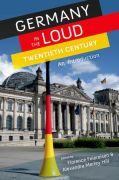
Germany in the loud twentieth century: an introduction
Feiereisen, Florence
Hill, Alexendra Merley
This book introduces German Sound Studies using a transdisciplinary approach. It invites readers to auralize space by describing characteristically Germansoundscapes in the long twentieth century, including the noisy city of the early 1900s, the sounds of East and West Germany, and hip-hop soundscapes of themillennium. Germany in the Loud Twentieth Century seeks to understand recent German history and contemporary German culture through its sounds and musics, noises and silences, using the means and modes of the emerging field of Sound Studies. German soundscapes present a particularly fertile field for investigation and understanding, Feiereisen and Hill argue, due to such unique factorsin Germany's history as its early and especially cacophonous industrialization, the sheer loudnessof its wars, and the possibilities of shared noises in its division and reunification. Organized largely but not strictly chronologically, chapters use theunique contours of the German aural experience to examine how these soundscapes - the sonic environments, the ever-present arrays of noises with whicheveryone lives - ultimately reveal the possibility of "national" sounds. Together the chapters consider the acoustic national identity of Germany, or the cultural significance of sounds and silence, since the development and rise ofsound-recording and sound-disseminating technologies in the early 1900s Chapters draw examples from a remarkably broad range of contexts and historical periods, from the noisy urban spaces at the turn of the twentieth century to battlefields and concert halls toradio and television broadcasting to the hip hop soundscapes of today. As a whole, the book makes a compelling case for the scholarly utility of listeningto them. An online "Bonus Track" of teaching materials offers instructors practical tips for classroom use. Introduction to the Study of German Sounds: Tuning in to the Aural Ether, Florence Feiereisen and Alexandra Merley HillSection I: New Sounds in the 20th Century: Sounds, Noise, SilenceChapter 1: Escaping the Urban Din: A Comparative Study of Theodor Lessing's Antilrmverein (1908) and Maximilian Negwer's Ohropax (1907/8), John GoodyearChapter 2: When Only the Ears are Awake: Gnter Eich and the Acoustical Unconscious, Robert RyderSection II: Defining Space Through Sound: Battlefields and Concert HallsChapter 3: The Sonic Mindedness of the Great War: Viewing History through Auditory Lenses, Yaron JeanChapter 4: From Seat Cushions to Formulae: Understanding Spatial Acoustics inPhysics and Architecture, Sabine von FischerSection III: East and West: Sounds in the Shadow of the WallChapter 5: From the Boiler Room to the Hotel Room: Sound and Space in Wolfgang Hilbig's Das Provisorium (2000), Curtis SwopeChapter 6: Berlin Sounds: Audible Cartography of a Formerly Divided City, Nicole DietrichSection IV: The Politics of Sound: Walls with EarsChapter 7: Sound and Socialist Identity: Negotiating the Musical Soundscape in the Stalinist GDR, David TompinsChapter 8: Audibility is a Trap: Aural Panopticon in The Lives of Others (2006), Christiane BeuermannSection V: Soundscapers of the Millennium: Sound Art and Music SoundsChapter 9: Sound Art - New Only In Name: A Selected History of German Sound Works from the Last Century, Brett M. Van Hoesen and Jean-Paul PerrotteChapter 10: Ghettos, Hoods, Blocks: The Sounds of German Space in Rap and Hip-Hop, Maria StehleBibliographyIndex
- ISBN: 978-0-19-975938-5
- Editorial: Oxford University
- Encuadernacion: Rústica
- Páginas: 224
- Fecha Publicación: 22/12/2011
- Nº Volúmenes: 1
- Idioma: Inglés
